|
   |
|
Page 7 |
Newsletter 116, Spring 2017 © Hampshire Mills Group |
Quidhampton Mill, Overton
Richard Waldram
Part 1: History and Building
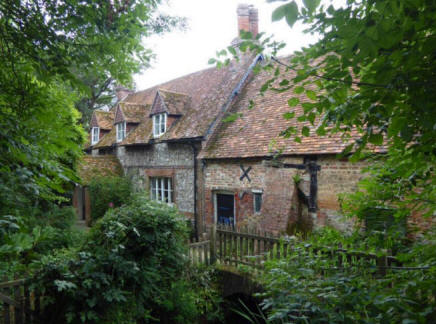 |
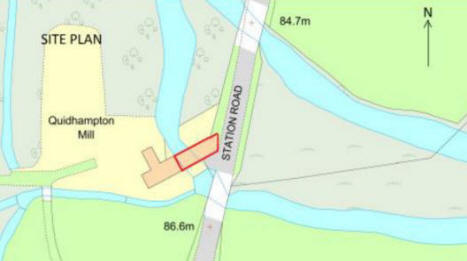 |
|
I have lived
in Overton for forty years and every time I
walked up Station Road I looked at
Quidhampton Mill and wondered vaguely what
was inside. Last August, I was updating the
information we have about Overton’s listed
buildings and asked the owners if I could
have a look inside the mill. Rather to my
surprise, my wish was granted. Being no
expert on water mills, I made sure I would
know a pit wheel from a wallower and read up
what was already known about this mill.
The mill is
one of four in Overton parish and lies only
a mile from the source of the River Test. At
the time of the Domesday Survey there were
two mills in the manor of Quidhampton. One
of them apparently soon fell into ruin, but
in the 14th century rolls of St Swithun's
there is frequent mention of the other, the
tithes of which were confirmed to the
almoner by John Syfrewast. This is probably
the present Quidhampton Mill.
At the
Hampshire Archives there are various leases
of Quidhampton manor and mill between 1669
and 1819 in which it is described as a
‘water grist mill or corn mill’ but no other
details are given. In 1763 John Webb,
yeoman and miller of Quidhampton, insured
his dwelling house for £50 and the utensils
and stock in his water corn mill (timber,
brick, and tiled) for £50. In 1819 the
Mill was in the possession of John Portal
who let it to Joseph Crimble. The Portal
family owned the paper making business at
Laverstoke and Bere Mills a few miles
downstream. In 1922, when electric power
was available, papermaking was transferred
to a factory next to Overton station just to
the north of Quidhampton Mill. Sometime
after 1921, a bucket wheel was put in the
mill to drive a water pump. It filled a
tank near the top of the hill to provide
running water to the newly built Station
Bungalows.
|
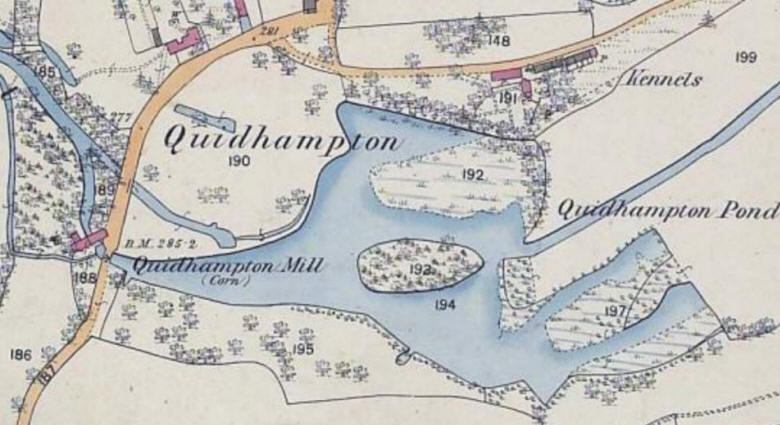
The extensive mill pond shown in the
Ordnance Survey map of 1873 was mainly
filled in sometime after 1961
|
|
Mills and Millers of Hampshire
records that John Loveless acquired the
lease in 1907 and held it until 1939 when
milling ceased. Quite by chance, I
discovered that this is not the whole story.
Just down Station Road lives a lady of 93
who grew up at the mill in the 1920s. John
Loveless was her grandfather who had
previously worked for the Crimbles at
Southington Mill to the west of Overton
village. Her father, also called John, was
born in 1893. He went off to the war in
1916 when he was 23 and served with the
Gloucester Regiment. He was badly wounded
in the head and leg and spent the next three
years in Roehampton Hospital. His daughter
said “he had a bad limp and was never the
same man again”. At some point,
however, he took over the lease of the mill.
It was probably just after 1923 when she
was born and her grandfather was 60.
She and her
sister played in the mill, whether it was
working or not, and it worked most days.
She remembers that it was noisy when the
wheel was running but it did not bother
them. Mostly they played ‘houses’ on the
top floor. They had a curtain across it and
this was their ‘den’. Catching rats around
the mill with their father was an endless
source of fun. They paddled in the mill
stream and the mill pond. Fishing for trout
was only for the gentry but the odd trout
did find its way to their table. She
thought they tasted of mud. They used an
eel trap, as all mills did, but she didn’t
like the taste of them either.
The farmers
brought their grain by horse and cart and
the sacks were taken in through the door on
the first floor by the road. The grain was
used to produce animal feed so the product
went back to the farmer who brought it.
She lived at the
mill till she married at the age of 20. She
does not know exactly why milling stopped or
when. When the war came, herds were reduced
to dairy cows only and arable production
increased to reduce dependence on imported
Canadian wheat. The ‘Ploughing-Up Campaign’
started in August 1939. Farmers were
instructed to plough two million acres of
grassland for the harvest of 1940 and grain
was reserved for human consumption. That
would have put John Loveless out of business
because he did not have the machinery for
removing impurities and making flour fit for
human consumption.
The mill was
listed Grade 2 in 1984 and is said to be a
17th century timber-framed
building with later alterations. The
miller’s house is 19th century.
In front of the mill is a footway above the
watercourses, formed by 3 brick arches
flanked by walling. |
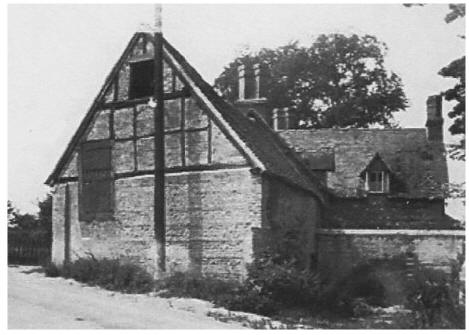 |
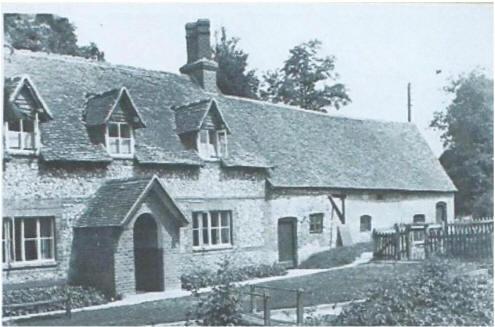
Historic
England Archive No 1731_035 |
|
The views above
were taken in 1951. The left one shows the
timber framing and the access door to the
stone floor from the road. The massive
brick buttresses and the tie rods (below
left) must have been put in after this
date. It had been evident for some time
that the roof was in danger (photo below
right, Tony Morris
www.overtonpictures.com, taken in
2005). In 2007 the whole mill house was
encased in scaffolding and the roof covered
with tarpaulins for a couple of years. |
|
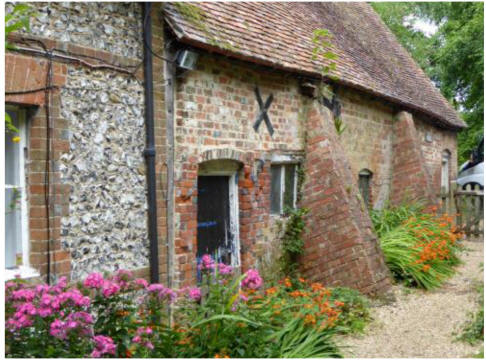 |
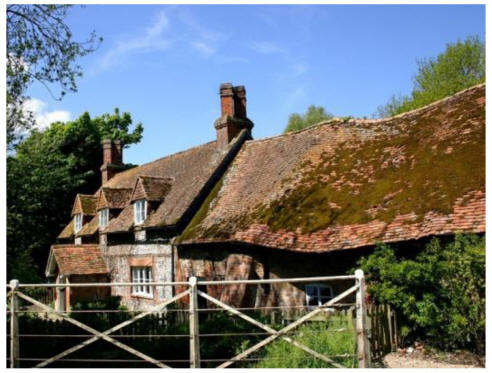 |
|
I found that
details of the planning application for
repairs were still on the Borough Council
website. There were three reasons for the
collapse. Two of the tie beams had been cut
resulting in outward thrust on the walls.
Some of the trusses had failed and the
purlins were not of adequate scantling. The
buttresses and tie rods (above) had failed
to solve the problem.
It was now
time to go and have a look. Knowing that
there was no electric power and very poor
daylight, I went armed with an extension
lead, a flood light and a torch. Inevitably
the extension lead was too short and I spent
a good deal of time stumbling around by
torch light amongst a lot of clutter trying
to get my bearings. But I soon realised
with great excitement that all the machinery
and equipment had been left exactly as it
was when the mill was closed. I also
realised I would need to come back, better
equipped to get photographs and survey the
whole building. This meant recruiting my
long-suffering wife to hold the end of a
tape measure. Fortunately, she likes this
kind of thing and in four hours the job was
done.
|
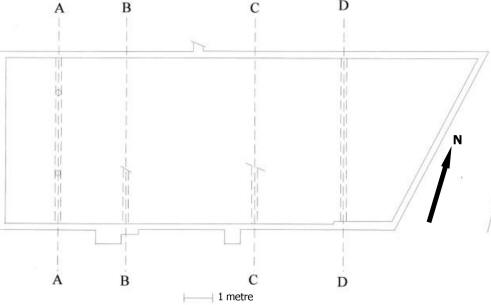 |
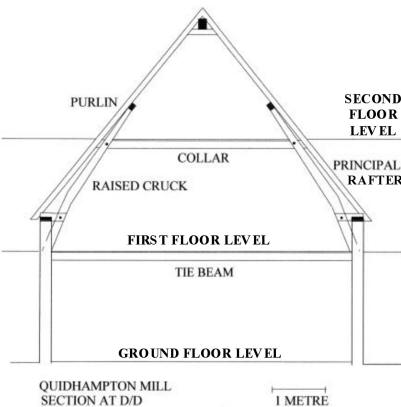 |
|
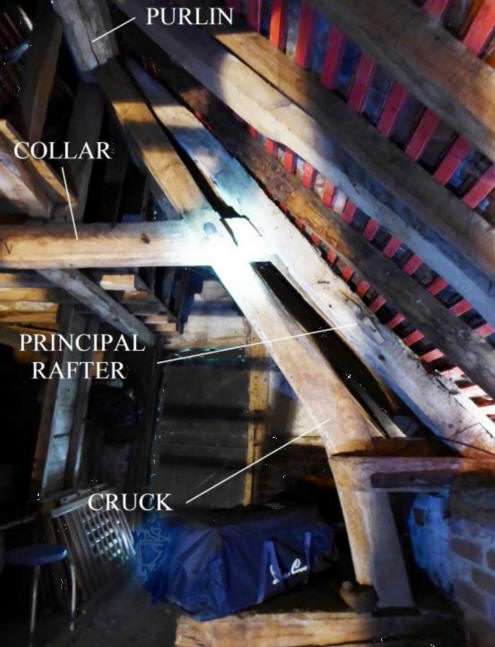
|
The building
is a four-bay structure, with three raised
cruck, arch-braced trusses at B, C, and D.
There is an
additional tie beam at A not associated with
a truss. Tie beams A and D are intact but
those at B and C have been cut, probably
when a new water wheel and machinery were
installed sometime in the 19th century. The
photograph left, taken at first floor level
looking east, shows the south end of truss D
which is the best preserved.
This form of
construction is unusual but is ideal for a
mill because it provides clear working space
on all three floors.
The
disadvantage is that it results in outward
thrust on the walls. If any tie beams are
cut, the whole structure depends on the
integrity of the collar, the cruck and the
wall. Eventually, four of the crucks
failed, the south wall began to lean, the
purlins sagged and the roof collapsed. New
purlins were put in supported by vertical
posts from ground level, leaving the
original roof structure otherwise intact.
This is how the building was saved.
|
|
 |

The photo
above shows one of the new oak posts
supporting the purlins from ground level. |
|
Part 2: Mill
Machinery is in the next newsletter.
 |
|
|
|
